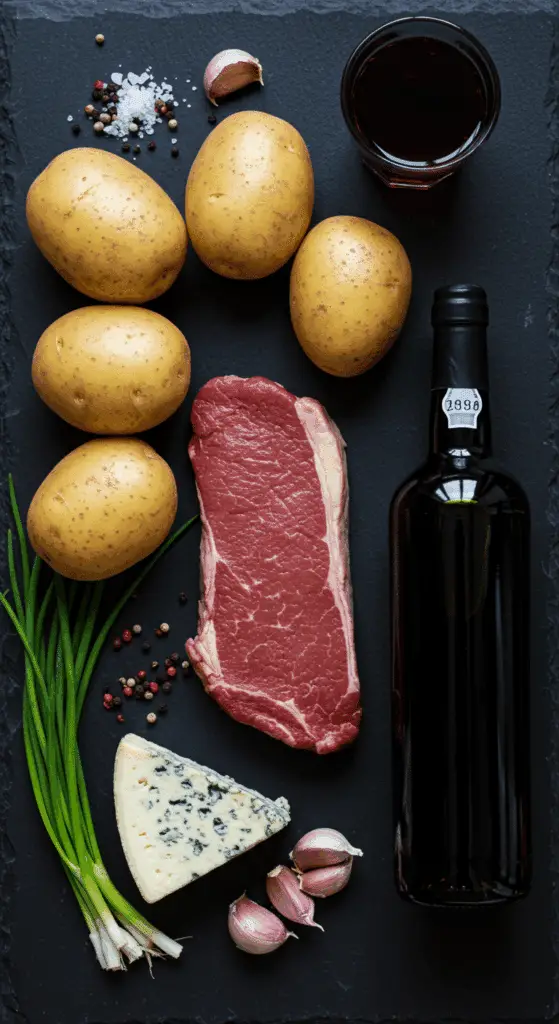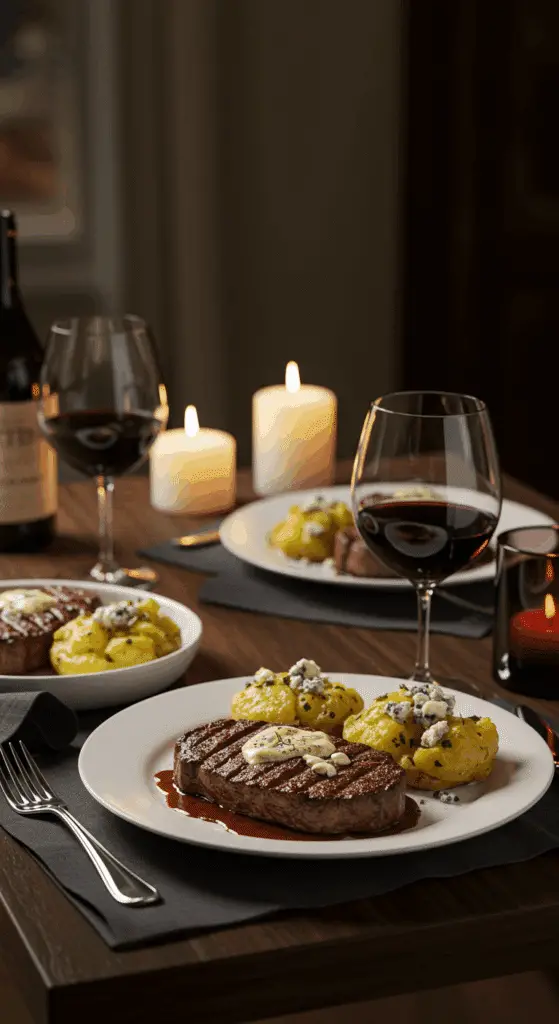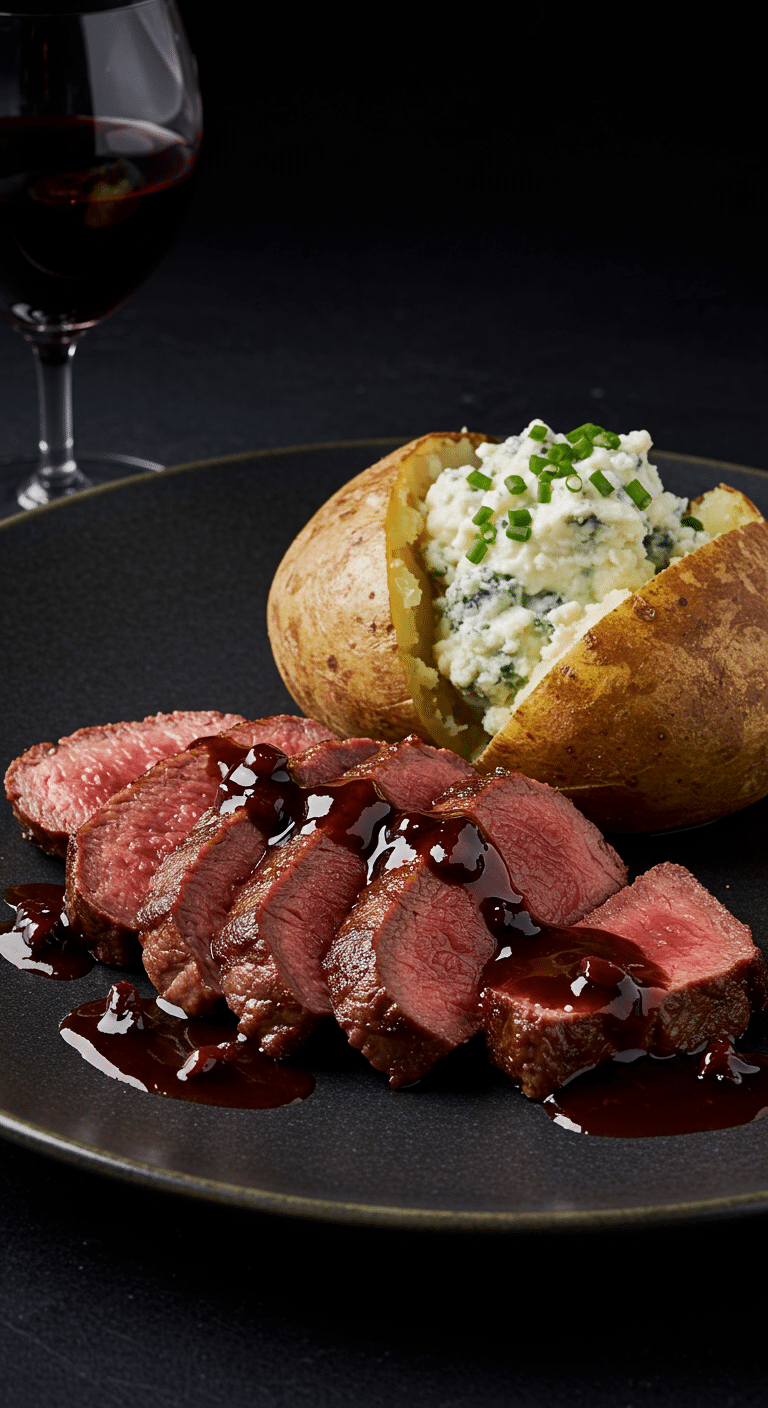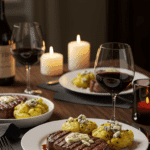Craving that perfect steakhouse dinner experience without the hefty price tag or the need for a reservation? What if you could cook a juicy, perfectly seared steak with a rich pan sauce and decadent blue cheese potatoes right in your own kitchen? This recipe for Steak With Blue Cheese Potatoes is your ultimate guide to making that dream a delicious reality.
This isn’t just a meal; it’s an event. We’ll walk you through every step, from achieving the perfect crispy-skinned baked potato to searing a steak with a deep brown crust, and finishing with a glossy, restaurant-quality pan sauce. Get ready to impress yourself, your family, or that special someone with a truly memorable dinner.
Table of Contents
Table of Contents
Recipe Overview: Your Steakhouse Dinner at Home
What makes this Steak With Blue Cheese Potatoes recipe a showstopper is the combination of classic flavors and smart, accessible techniques. We use a clever microwave-to-oven trick for fluffy, crispy-skinned potatoes in a fraction of the time. The steak is seared to perfection using a cast-iron skillet, and the entire meal is brought together by an elegant port wine pan sauce that you’ll make in just minutes.
| Metric | Time / Level |
| Total Time | 45 minutes |
| Active Prep Time | 20 minutes |
| Difficulty Level | Intermediate |
| Servings | 4 |
The Essential Ingredients for a Steakhouse Feast
This meal relies on a handful of high-quality ingredients to deliver its signature rich and savory flavors.
- Boneless Top Sirloin Steak: We call for a thick, 1 1/2-inch cut of top sirloin. It’s a fantastic choice that offers a wonderfully beefy flavor and a satisfyingly tender texture, all at a more approachable price point than some other steakhouse cuts.
- Russet Potatoes: The undisputed king of the baked potato. Russets have a high starch content and thick skin, which results in an interior that bakes up incredibly light and fluffy and a skin that gets wonderfully crisp and salty in the oven’s high heat.
- Soft Blue Cheese: This is the key to our decadent potato topping. Its signature salty, tangy funk is the perfect partner for a rich, beefy steak. You can choose a milder, creamy Danish Blue or Gorgonzola, or go for a sharper, more intense Stilton or Roquefort.
- Ruby Port or Red Wine: This forms the base of our elegant pan sauce. A ruby port will create a slightly sweeter, richer sauce with notes of dark fruit. A dry red wine, like a Cabernet Sauvignon or Merlot, will yield a more classic, savory sauce.
- Cold Unsalted Butter: This is our professional finishing touch for the sauce. The classic French technique of swirling cold butter into a warm sauce at the end is called monter au beurre. It emulsifies the sauce, making it glossy, velvety smooth, and rich without any cream.
- Fresh Herbs: A mix of fresh parsley, chives, and/or scallions stirred into the blue cheese and sour cream topping adds a crucial burst of fresh, bright flavor that cuts through the richness.

Step-by-Step to a Perfect Steak Dinner
Follow these detailed steps to orchestrate this restaurant-quality meal in your own kitchen.
Step 1: Cook the “Perfect” Baked Potatoes First, let’s get the potatoes going using our time-saving method. Preheat your oven to 425°F (220°C).
Pierce each potato several times with a fork. This allows steam to escape and prevents them from exploding in the microwave. Microwave the potatoes on high for about 12 minutes, or until a fork can be easily inserted but the center still feels slightly firm.
Carefully remove the hot potatoes from the microwave. Brush them all over with olive oil, then place them directly on the oven rack. Bake for about 10 minutes. This final blast of high heat is what makes the skins wonderfully crisp. Once done, keep them warm.
Step 2: Prepare the Blue Cheese Topping While the potatoes are in the oven, you can prepare the delicious topping. In a small bowl, combine the crumbled soft blue cheese, the sour cream, and your choice of chopped fresh herbs (parsley, chives, or scallions). Mix everything together and set it aside.
Step 3: Sear the Steak to Perfection Now for the main event. Pat your sirloin steak completely dry with paper towels. Season it generously on all sides with kosher salt and freshly ground black pepper, then rub it all over with 1 tablespoon of olive oil.
Heat a large cast-iron skillet over medium-high heat until it is very hot.
Pro Tip: Using a cast-iron skillet is key for getting a deep, even crust on a steak. It holds heat incredibly well.
Sprinkle the hot skillet with 1/2 teaspoon of salt and a light drizzle of olive oil. Carefully place the seasoned steak in the center of the skillet. Immediately place another heavy skillet (like another cast-iron pan) or a foil-wrapped brick directly on top of the steak. This weight ensures maximum contact with the hot surface, creating an incredible crust.
Cook the steak for 4 minutes without moving it. Remove the top skillet and flip the steak over. Replace the top skillet and cook the second side for 3 minutes.
Reduce the heat to low, remove the top skillet for the final time, and continue to cook for another 1 to 4 minutes, until the steak reaches your desired doneness. For medium-rare, an instant-read thermometer should register 130−135°F (54−57°C).
Transfer the cooked steak to a cutting board and let it rest. Do not clean the skillet!
Step 4: Make the Port Wine Pan Sauce Return the skillet with all the flavorful browned bits to the stove over medium-high heat. Add the sliced shallot or diced red onion and cook for about 1 minute until slightly softened.
Pour in the ruby port or red wine. Let it boil, scraping the bottom of the pan with a wooden spoon to release all those delicious browned bits (the “fond”). Continue to boil until the liquid has thickened and reduced by about half, which should take about 4 minutes.
Stir in the beef broth and any juices that have accumulated on the plate from the resting steak. Cook for another 5 minutes to allow the sauce to reduce further.
Finally, remove the skillet from the heat. Whisk in the 3 tablespoons of cold unsalted butter, one tablespoon at a time, until the sauce is glossy and velvety smooth. Season with salt and pepper to taste.
Step 5: Rest, Slice, and Serve Letting the steak rest for at least 5-10 minutes before slicing is the most important step for a juicy steak. This allows the juices to redistribute throughout the meat.
To serve, split the warm baked potatoes open and top them generously with the blue cheese mixture. Slice the rested steak against the grain into 1/2-inch thick pieces.
Divide the sliced steak among your plates, serve alongside a loaded blue cheese potato, and spoon the rich port wine sauce over the steak. Serve immediately.

The Perfect Steak With Blue Cheese Potatoes
A classic steakhouse-style meal featuring pan-seared sirloin steak, loaded baked potatoes, and a rich red wine pan sauce. The potatoes are first cooked in the microwave and then finished in the oven for a fluffy interior and crisp skin, then topped with a savory mixture of blue cheese, sour cream, and fresh herbs. The steak is seared in a cast-iron skillet, and a flavorful pan sauce is made in the same pan with shallots, port or red wine, and beef broth, finished with butter.
- Prep Time: 10 minutes
- Cook Time: 25 minutes
- Total Time: 40 minutes (includes resting time)
- Yield: 4 servings
- Category: Main Course
- Method: Pan-Searing, Baking, Microwaving
- Cuisine: American
- Diet: Gluten Free
Ingredients
- 4 medium russet potatoes
- 1 tablespoon extra-virgin olive oil, plus more for brushing
- 1 1/2 pounds boneless top sirloin steak (about 1 1/2 inches thick)
- Kosher salt and freshly ground pepper
- 3 ounces soft blue cheese (about 3/4 cup)
- 3 tablespoons sour cream
- 3/4 cup chopped fresh parsley, chives and/or scallions
- 1 shallot, sliced, or 2 tablespoons diced red onion
- 1/2 cup ruby port or red wine
- 1 cup low-sodium beef broth
- 3 tablespoons cold unsalted butter
Instructions
- Preheat the oven to 425°F.
- Cook the Potatoes: Pierce the potatoes with a fork, then microwave for about 12 minutes until they can be easily pierced but are still slightly firm. Brush the potatoes with olive oil and bake them directly on the oven rack for about 10 minutes, until the skins are crisp and they are tender throughout. Keep warm.
- Prepare the Steak and Topping: While the potatoes are in the oven, season the steak with salt and pepper and rub it with 1 tablespoon of olive oil. In a small bowl, mix together the blue cheese, sour cream, and herbs.
- Cook the Steak: Heat a large cast-iron skillet over medium-high heat. Sprinkle the skillet with 1/2 teaspoon of salt, drizzle lightly with olive oil, then add the steak.
- Weigh the steak down with a second heavy skillet placed on top. Cook for 4 minutes until browned.
- Flip the steak, replace the top skillet, and cook for 3 more minutes to brown the other side.
- Reduce the heat to low, remove the top skillet, and cook for 1 to 4 more minutes for medium-rare. Transfer the steak to a plate to rest.
- Make the Pan Sauce: Return the skillet to medium-high heat. Add the sliced shallot and port wine. Boil, scraping up any browned bits, until the liquid has thickened, about 4 minutes.
- Stir in the beef broth and any juices from the resting steak. Cook for 5 minutes to reduce. Whisk in the cold butter until the sauce is glossy.
- Serve: Split open the warm baked potatoes and top with the blue cheese mixture. Thinly slice the rested steak. Serve the steak with the potatoes and spoon the pan sauce over the steak.
Notes
- Using a microwave to par-cook the potatoes is a time-saving trick that ensures they are fully cooked and fluffy inside after a short time in the oven.
- Pressing the steak down with another heavy skillet helps to create a beautiful, even crust.
- Letting the steak rest before slicing is crucial for keeping it juicy. The juices are then added to the pan sauce for extra flavor.
Storage and Make-Ahead Tips
While a steak dinner is best enjoyed fresh, here are some tips for handling leftovers or prepping ahead.
- Make-Ahead: The blue cheese and sour cream topping can be made up to 2 days in advance and stored in an airtight container in the refrigerator.
- Storage: Store any leftover sliced steak and potatoes in separate airtight containers in the refrigerator for up to 2 days.
- Reheating: The best way to reheat steak without overcooking it is quickly in a hot skillet with a little butter or oil. You can reheat the potato in the microwave or oven.
For more recipe follow my Pinterest account
Creative Recipe Variations
This classic steakhouse formula is a great base for experimentation.
- Try a Different Cut of Steak: This pan-searing method is fantastic for other thick-cut steaks like a boneless ribeye, New York strip, or even a tender filet mignon. Simply adjust the final cooking time based on the thickness and your desired doneness.
- Gorgonzola Cream Sauce: If you prefer a creamy sauce, you can easily adapt this recipe. After sautéing the shallots, skip the port wine and broth. Instead, add 1 cup of heavy cream to the skillet. Let it simmer and reduce until it thickens, then turn off the heat and stir in the blue cheese until you have a rich, decadent cream sauce.
- Twice-Baked Blue Cheese Potatoes: To make the potatoes even more luxurious, after they are fully baked, slice them in half lengthwise. Scoop out the fluffy interior into a bowl, leaving the skins intact. Mash the potato flesh with the blue cheese mixture, then spoon it back into the potato skins. Top with a little extra cheese and bake at 400°F until hot and bubbly.
Enjoy Your Steakhouse Experience!
You’ve just created an incredible, restaurant-quality meal in the comfort of your own home. This recipe for Steak With Blue Cheese Potatoes proves that with a few smart techniques, you can easily master a show-stopping dinner that is perfect for date night, a celebration, or any time you want to treat yourself.
We hope you feel empowered to tackle this special occasion meal with confidence and enjoy every last, delicious bite.
If you loved this recipe, please leave a comment below or share it with a friend who deserves a great steak dinner!
Frequently Asked Questions (FAQs)
Q1: What is the best way to tell when a steak is done?
While the “touch test” can be useful for experienced cooks, the most reliable and foolproof method is to use an instant-read digital meat thermometer. For medium-rare, aim for an internal temperature of 130−135°F (54−57°C). For medium, 135−145°F (57−63°C).
Q2: Why is it so important to let a steak rest after cooking?
When you cook a steak, the muscle fibers tense up and push all the juices toward the center. Letting the steak “rest” on a cutting board for 5-10 minutes allows those muscle fibers to relax and the juices to redistribute evenly throughout the meat. If you slice into it immediately, all those delicious juices will run out onto your cutting board, leaving you with a dry steak.
Q3: What does it mean to slice a steak “against the grain”?
“The grain” refers to the direction that the muscle fibers are aligned in the meat. You can see them as long, parallel lines running through the steak. By slicing perpendicular to (or “against”) these lines, you are shortening the muscle fibers, which makes each bite significantly more tender and easier to chew.
Q4: Can I make this recipe without a cast-iron skillet?
A heavy-bottomed stainless steel skillet is the next best choice. It can also get very hot and will develop a good “fond” (the browned bits) for the pan sauce. Avoid using thin or nonstick skillets (unless they are specifically rated as ovenproof), as they don’t hold heat as well for searing and often cannot be transferred to a hot oven.
Q5: What’s the point of weighing the steak down?
Weighing the steak down with another heavy skillet ensures that the entire surface of the steak maintains direct, even contact with the hot cast iron. This promotes a faster, deeper, and more uniform browning, creating that coveted, delicious steakhouse crust.


